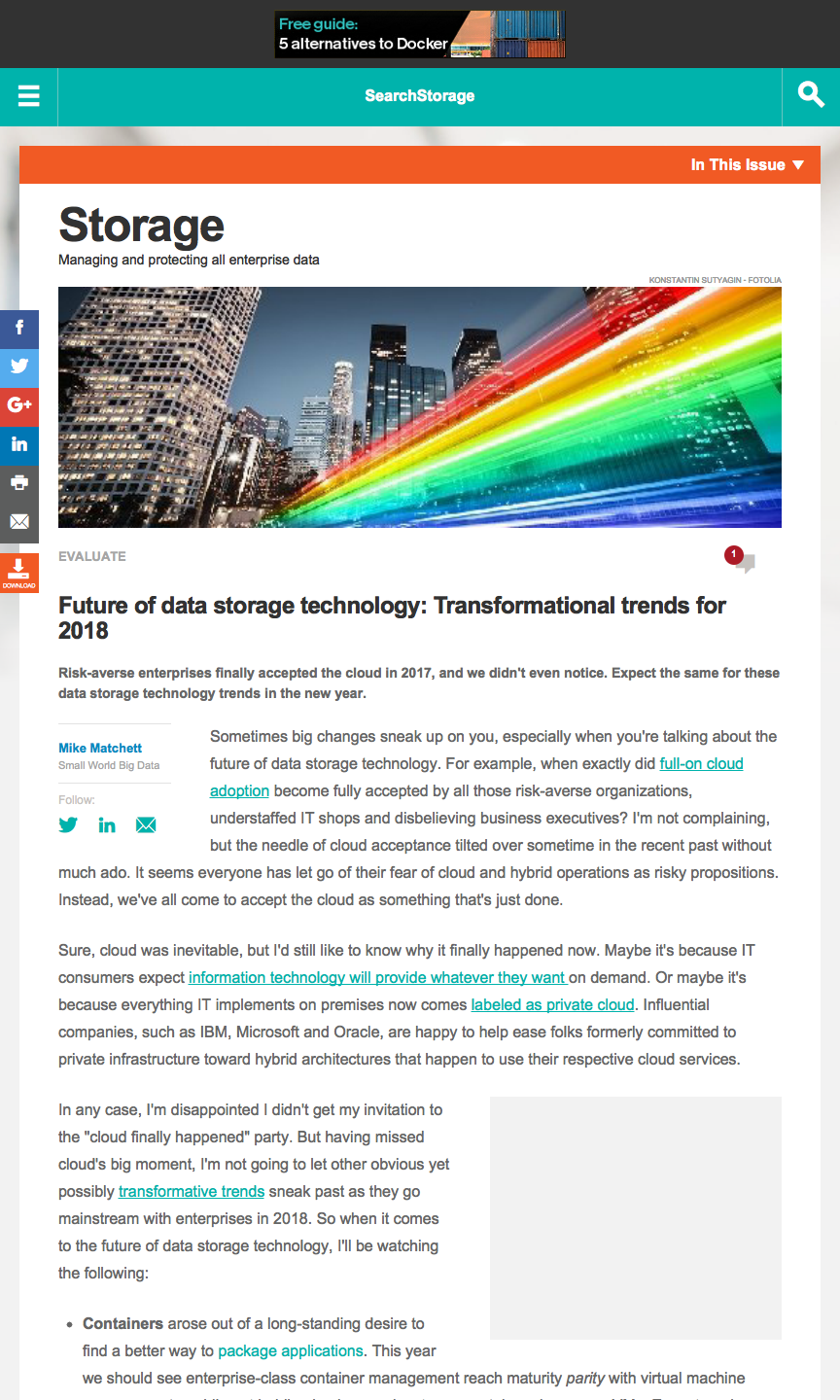Future of data storage technology: Transformational trends for 2018

An IT industry analyst article published by SearchStorage.
 Risk-averse enterprises finally accepted the cloud in 2017, and we didn’t even notice. Expect the same for these data storage technology trends in the new year.
Risk-averse enterprises finally accepted the cloud in 2017, and we didn’t even notice. Expect the same for these data storage technology trends in the new year.
Mike Matchett
Small World Big Data
Sometimes big changes sneak up on you, especially when you’re talking about the future of data storage technology. For example, when exactly did full-on cloud adoption become fully accepted by all those risk-averse organizations, understaffed IT shops and disbelieving business executives? I’m not complaining, but the needle of cloud acceptance tilted over sometime in the recent past without much ado. It seems everyone has let go of their fear of cloud and hybrid operations as risky propositions. Instead, we’ve all come to accept the cloud as something that’s just done.
Sure, cloud was inevitable, but I’d still like to know why it finally happened now. Maybe it’s because IT consumers expect information technology will provide whatever they want on demand. Or maybe it’s because everything IT implements on premises now comes labeled as private cloud. Influential companies, such as IBM, Microsoft and Oracle, are happy to help ease folks formerly committed to private infrastructure toward hybrid architectures that happen to use their respective cloud services.
In any case, I’m disappointed I didn’t get my invitation to the “cloud finally happened” party. But having missed cloud’s big moment, I’m not going to let other obvious yet possibly transformative trends sneak past as they go mainstream with enterprises in 2018. So when it comes to the future of data storage technology, I’ll be watching the following:
Containers arose out of a long-standing desire to find a better way to package applications. This year we should see enterprise-class container management reach maturity parity with virtual machine management — while not holding back any advantages containers have over VMs. Expect modern software-defined resources, such as storage, to be delivered mostly in containerized form. When combined with dynamic operational APIs, these resources will deliver highly flexible programmable infrastructures. This approach should enable vendors to package applications and their required infrastructure as units that can be redeployed — that is, blueprinted or specified in editable and versionable manifest files — enabling full environment and even data center-level cloud provisioning. Being able to deploy a data center on demand could completely transform disaster recovery, to name one use case.
Everyone is talking about AI, but it is machine learning that’s slowly permeating through just about every facet of IT management. Although there’s a lot of hype, it’s worth figuring out how and where carefully applied machine learning could add significant value. Most machine learning is conceptually made up of advanced forms of pattern recognition. So think about where using the technology to automatically identify complex patterns would reduce time and effort. We expect the increasing availability of machine learning algorithms to give rise to new storage management processes. These algorithms can produce storage management processes that can learn and adjust operations and settings to optimize workload services, quickly identify and fix the root causes of abnormalities, and broker storage infrastructure and manage large-scale data to minimize cost.
Management as a service (MaaS) is gaining traction, when looking at the future of data storage technology. First, every storage array seemingly comes with built-in call home support replete with management analytics and performance optimization. I predict that the interval for most remote vendor management services to quickly drop from today’s daily batch to five-minute streaming. I also expect cloud-hosted MaaS offerings are the way most shops will manage their increasingly hybrid architectures, and many will start to shift away from the burdens of on-premises management software…(read the complete as-published article there)
